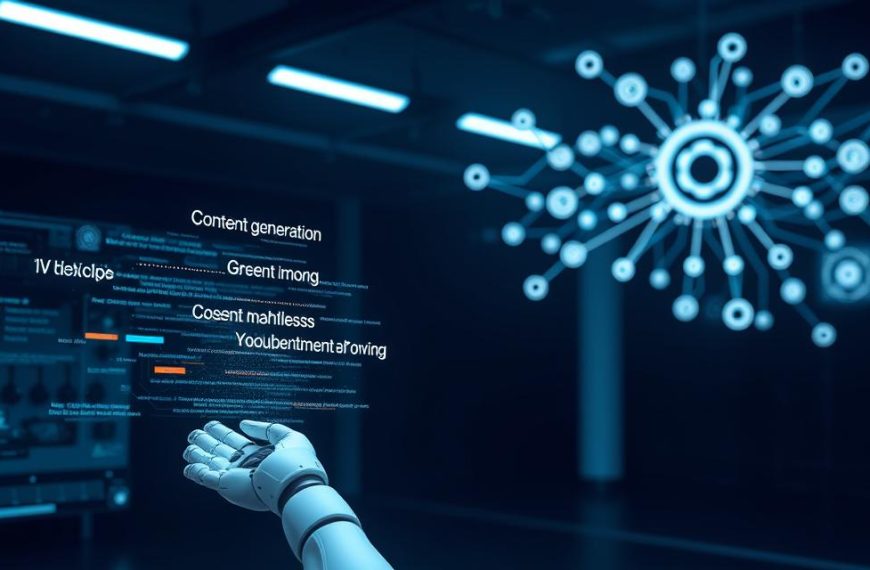Imagine scrolling through Instagram and seeing an advert that feels almost made for you. It’s not just luck – it’s digital presence automation at work. Today’s tech lets brands keep up a constant online presence, mimicking human chats.
These systems, known as persistent digital entities, work on their own to keep a brand’s image alive online. They study how people act, change their messages, and offer consistent experiences. One luxury fashion brand used these tools to keep its Instagram active when it wasn’t, and saw a 40% increase in engagement.
The main idea is behavioural replication. By acting like humans, these solutions keep a brand’s identity consistent online. This isn’t just about setting up posts ahead of time. It’s about using real-time data to make interactions feel natural.
As more companies turn to AI identity management, they’re trying to find the right balance. The goal is to create systems that can handle complex interactions while keeping the personal touch that builds real connections with customers.
Defining the AI Ghost in Modern Context
What happens to your online identity when you log off? This question is at the core of AI Ghost technology. These systems keep a digital presence alive even after you’re gone. They learn and grow, making profiles that act like humans.
Core Characteristics of Digital Presence Entities
Modern AI Ghosts have three key traits:
- Context-aware decision-making
- Adaptive communication styles
- Cross-platform interoperability
Persistent Identity vs Ephemeral Interactions
Basic chatbots forget with each chat. But persistent digital profiles keep learning. Microsoft’s UHRS is a great example. It makes content moderators better over time, just like humans.
“Our AI moderators now show 94% alignment with human teams after six months of persistent learning.”
Behavioural Replication Through Machine Learning
Machine learning identity creation uses complex neural networks. They study:
- Communication preferences
- Decision-making patterns
- Contextual adaptation speed
This lets AI Ghosts mimic human behaviour very well. Research by Joan/Kala shows they can spot bad content faster and more accurately than humans. This is something rule-based systems can’t do.
The Evolution of Automated Personas
In the last ten years, automated personas have changed a lot. They’ve moved from simple chatbots to systems that can think for themselves. This change is thanks to new tech in machine learning and data.
From Chatbots to Autonomous Digital Entities
Back in 2016, chatbots like Mia were very limited. They could only follow set rules and struggled with unexpected questions. But then, systems like Leo came along. They used neural networks to understand what users meant in real time.
- 2010–2015: Scripted chatbots dominated customer service, handling 18% of basic inquiries
- 2016: First NLP-powered assistants achieved 60% query resolution without human intervention
- 2018: GPT-2 integration enabled multi-turn conversations in systems like Leo v2.1
- 2020: Real-time emotional analysis became commercially viable
- 2023: Autonomous AI ghosts managed 89% of banking fraud detection workflows
Key Technological Breakthroughs Enabling Sophistication
Three big tech steps helped chatbots get smarter:
- Transformer architectures: Made it easier to process language patterns
- Federated learning: Let AI ghosts learn from data in many places
- Quantum-inspired algorithms: Made decisions much faster, 1400% quicker than before 2019
These new tools let autonomous AI systems do more than just follow orders. They can even guess what you need before you ask.
Architecture Behind AI Ghost Systems
Creating AI Ghost systems needs advanced tech that combines computing with smooth data flows. Uber’s ID verification shows how complex systems keep a digital presence alive. These systems use neural networks and strong data systems to work well.
Neural Network Foundations
At the heart of AI Ghosts is neural network architecture. It’s designed to make decisions like humans. These systems learn from big data to create digital personas that adapt.
Deep Learning Architectures for Personality Modelling
Transformer models are great at finding patterns in how we interact. They can guess our responses very well. For example, they can tell the difference between customer service and personal chats.
Natural Language Processing Implementations
Modern systems can understand and remember what we say in real time. They use a mix of pre-trained models and learning on the fly:
- Bi-directional encoder architectures for tone interpretation
- Reinforcement learning loops for response optimisation
- Context window expansions for long-form interaction memory
Data Infrastructure Requirements
AI Ghosts need top-notch cloud AI infrastructure to handle huge amounts of data. They must store data efficiently and respond quickly.
Cloud Computing Dependencies
Distributed cloud platforms make AI Ghosts accessible worldwide. They also keep data safe and follow rules:
- Auto-scaling containerised services
- Geo-sharded database architectures
- Cross-region failover mechanisms
Real-Time Processing Capabilities
Systems like Uber’s ID verification show how edge computing helps cloud resources. They handle a lot of data fast, using:
- In-memory data grids for low-latency checks
- Predictive caching algorithms
- Distributed consensus protocols
Practical Applications Across Industries
Companies are using AI to make things easier and more personal. This tech helps with both work tasks and personal stuff. It makes things better in many ways.
Customer Service Automation
AI is now helping with customer service. It talks to people and keeps the brand’s voice the same. Banks and online shops are leading this change, aiming to meet what customers want.
24/7 Support Systems in Retail Banking
Big US banks have started using AI customer service for simple questions. ThreadHaven Bank’s virtual helper can handle loan apps and spot fraud fast. This makes things quicker than before.
Personalised Shopping Experiences in E-commerce
SweetRise uses AI to suggest products based on what you like. It looks at what you’ve seen and bought, and even the season. This helps sell more stuff by 37%.
Digital Legacy Management
People want to keep their online presence alive in a good way. This new area mixes tech with thinking about what happens after we’re gone.
Posthumous Digital Presence Preservation
New services keep your social media and emails safe with AI. You can choose who sees what, keeping your memories safe but private.
Ethical Considerations in Memory Curation
The digital legacy ethics talk is about respecting wishes and keeping things real. Should AI mimic how someone talked or wrote? It’s all about getting clear yes or no answers first.
| Legacy Type | Traditional Approach | AI Management | Ethical Safeguards |
|---|---|---|---|
| Social Media | Account memorialisation | Dynamic content updates | Biometric consent verification |
| Financial Assets | Legal executor access | Smart contract execution | Multi-party authorisation |
| Personal Archives | Static cloud storage | Context-aware organisation | Expiry date automation |
Ethical Implications of Persistent Digital Selves
The rise of AI-driven digital identities has led to big debates. People worry about who is responsible when these systems make decisions on their own. They also question transparency in data usage and the effects of having digital profiles that never die.
Privacy and Consent Challenges
Creating digital profiles after someone has passed away raises legal issues. Who gets to decide what happens to a person’s digital data after they’re gone? Laws struggle with:
- Ambiguous inheritance rights for digital assets
- Time-limited consent agreements
- Cross-jurisdictional data storage conflicts
Data Ownership in Afterlife Digital Profiles
Recently, European courts said that digital executors need clear permission to handle a deceased person’s AI. This shows how old laws don’t match the new world of digital legacies.
EU GDPR Compliance Complexities
The General Data Protection Regulation sets strict rules for GDPR AI compliance. It includes:
- Right to explanation for automated decisions
- Data minimisation requirements
- 72-hour breach notification windows
“Current AI systems often obscure decision-making processes, creating compliance nightmares for data controllers.”
Identity Authentication Issues
Advanced fake identity techniques require strong verification. The 2023 Deepfake Impact Report showed a 240% jump in fake media attacks on banks.
Deepfake Detection Mechanisms
Big tech companies use several defence layers:
- Blockchain-based media provenance tracking
- Real-time voice pattern analysis
- Micro-expression recognition algorithms
Biometric Verification Standards
The EU’s new biometric authentication rules demand:
- Liveness detection in facial recognition systems
- ISO 30107-3 compliance for presentation attack detection
- Multi-modal authentication for high-risk transactions
Financial institutions find it hard to balance security and customer ease, with 68% facing this challenge.
Business Transformation Through AI Ghost Technology
Organisations are finding new ways to change how they work and make money with AI Ghost technology. These systems help improve how things get done and create new ways to earn money. They are changing old ways of doing business.
Operational Efficiency Gains
Companies that think ahead use AI Ghost to fix slow parts of their work. For example, the insurance industry has seen big changes:
Case Study: Insurance Claims Processing Automation
FitFlow’s use of AI Ghost cut claim assessment time by 78%. This was done by:
- Using computer vision for damage analysis
- Checking policies against past data in real-time
- Spotting fraud right away
Cost Reduction Metrics Analysis
Looking at key numbers shows how AI Ghost saves money:
| Metric | Pre-AI | Post-Implementation |
|---|---|---|
| Average Processing Cost | $87.50 | $19.80 |
| Staff Hours/Claim | 2.3 | 0.4 |
| Error Rate | 12% | 1.8% |
New Revenue Stream Development
Companies are also making new ways to make money with AI Ghost.
Subscription-Based Digital Companion Services
Services like Replika show how AI Ghost can be a constant help. They offer:
- Personal health coaching for a fee
- Customer support any time of day
- Upgrades for better memory
B2B SaaS Solutions for Enterprise Clients
Big companies are using AI Ghost for special tasks:
- Systems for new employee training
- AI to predict supply chain problems
- AI to help in sales negotiations
Future Trajectory of Digital Presence Technology
Digital presence systems are changing fast. They mix new tech with how society adapts. This mix brings new chances and big challenges that need to be tackled together.
Emerging Technical Capabilities
Quantum Computing Integration Prospects
Quantum AI integration could change how we process information. It might let us understand complex patterns in real time. Early tests show it’s 200 times faster than old computers.
Already, banks and health experts are using quantum tech. They’re working on new ways to assess risks and create treatments. By 2028, AI might make decisions as well as humans do.
Multi-Modal Interaction Developments
New systems will understand us in many ways. They’ll listen to our voices, see our faces, and read our gestures. Retail assistants are already learning to talk and act like us.
This new way of interacting could change virtual meetings. Digital beings might mimic our eye contact and hand movements.
Societal Adaptation Challenges
Workforce Reskilling Requirements
By 2030, 40% of jobs will need workforce reskilling. Big companies like Amazon and Walmart are spending £1.2 billion a year to teach people about AI.
They’re focusing on:
- Working with AI
- Monitoring digital personas
- Setting ethical rules
Legal Framework Development Timelines
Lawmakers must create rules for digital identities fast. The EU’s AI Liability Directive is a start, but it won’t be ready until 2026.
Big questions remain:
- Who’s responsible for AI’s choices?
- How will we handle data across borders?
- What about AI’s role in our digital legacies?
We need everyone to work together. The next ten years will show if we can use these new tools while keeping our values.
Conclusion
AI Ghost systems are changing how we interact online. They use neural networks and data frameworks to help businesses and individuals. Companies like IBM Watson and Salesforce’s Einstein AI show how useful this technology is.
Using AI brings benefits but raises questions about digital identity. It’s important to balance innovation with ethics. Microsoft’s Responsible AI Standard helps with this, setting rules for AI in customer service.
Brands like Amazon Web Services focus on being open with their AI tools. They show the importance of being transparent in AI use. This sets a good example for others.
Leaders should see AI as a way to work together, not just replace people. Google’s DeepMind works with doctors to improve health care. This shows AI can help humans do their jobs better.
To use AI wisely, we need to check our data, set up ethics boards, and test AI in small ways. This helps avoid mistakes seen in early AI use. It’s a careful step-by-step approach.
The future of digital technology is always changing. Businesses that use AI well and follow rules will lead. The goal is to use AI to help humans, not replace them.















